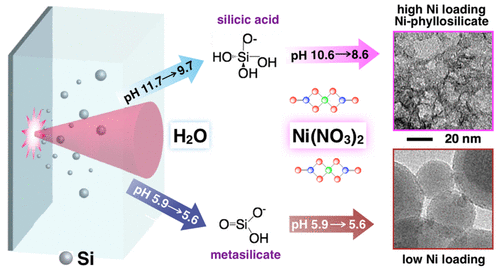当前位置:
X-MOL 学术
›
J. Phys. Chem. C
›
论文详情
Our official English website, www.x-mol.net, welcomes your
feedback! (Note: you will need to create a separate account there.)
Mechanism of Nickel Phyllosilicate Formation by Laser Ablation in Liquid
The Journal of Physical Chemistry C ( IF 3.3 ) Pub Date : 2020-05-26 , DOI: 10.1021/acs.jpcc.0c03732 Mallory G. John 1 , Katharine Moore Tibbetts 1
The Journal of Physical Chemistry C ( IF 3.3 ) Pub Date : 2020-05-26 , DOI: 10.1021/acs.jpcc.0c03732 Mallory G. John 1 , Katharine Moore Tibbetts 1
Affiliation

|
One-step synthesis of nickel-phyllosilicate (Ni-PS) nanocomposites was achieved using a femtosecond-reactive laser ablation in liquid (fs-RLAL) technique. The focusing of intense femtosecond laser pulses onto a silicon wafer immersed in aqueous nickel nitrate generated Ni-PS with high Ni loading in excess of 20 wt % under alkaline pH conditions. Analysis of the dissolved species in solution present after laser processing revealed that silicic acid was the key dissolved ablation product that reacted with the nickel nitrate to form the Ni-PS under alkaline conditions. When the solution was below pH 7, no silicic acid was generated from ablation, and consequently, no Ni-PS was formed in the dried product. The mechanism of Ni-PS formation from fs-RLAL of a silicon wafer immersed in aqueous nickel nitrate solutions is discussed. On the basis of this mechanism, it is expected that the fs-RLAL method will be capable of generating a variety of metal-phyllosilicates from different metal salt precursors.
中文翻译:

液体中激光烧蚀形成邻苯二甲酸硅镍的机理
使用飞秒反应性液体激光烧蚀(fs-RLAL)技术实现了镍-页硅酸盐(Ni-PS)纳米复合材料的一步合成。飞秒激光脉冲聚焦到浸在硝酸镍水溶液中的硅片上,在碱性pH条件下产生的Ni-PS的Ni负载量超过20 wt%。对激光加工后溶液中存在的溶解物质的分析表明,硅酸是关键的溶解烧蚀产物,其在碱性条件下与硝酸镍反应形成Ni-PS。当溶液的pH低于7时,烧蚀不会产生硅酸,因此在干燥产物中不会形成Ni-PS。讨论了将fs-RLAL浸入硝酸镍水溶液中的硅片由fs-RLAL形成Ni-PS的机理。
更新日期:2020-06-18
中文翻译:

液体中激光烧蚀形成邻苯二甲酸硅镍的机理
使用飞秒反应性液体激光烧蚀(fs-RLAL)技术实现了镍-页硅酸盐(Ni-PS)纳米复合材料的一步合成。飞秒激光脉冲聚焦到浸在硝酸镍水溶液中的硅片上,在碱性pH条件下产生的Ni-PS的Ni负载量超过20 wt%。对激光加工后溶液中存在的溶解物质的分析表明,硅酸是关键的溶解烧蚀产物,其在碱性条件下与硝酸镍反应形成Ni-PS。当溶液的pH低于7时,烧蚀不会产生硅酸,因此在干燥产物中不会形成Ni-PS。讨论了将fs-RLAL浸入硝酸镍水溶液中的硅片由fs-RLAL形成Ni-PS的机理。













































 京公网安备 11010802027423号
京公网安备 11010802027423号